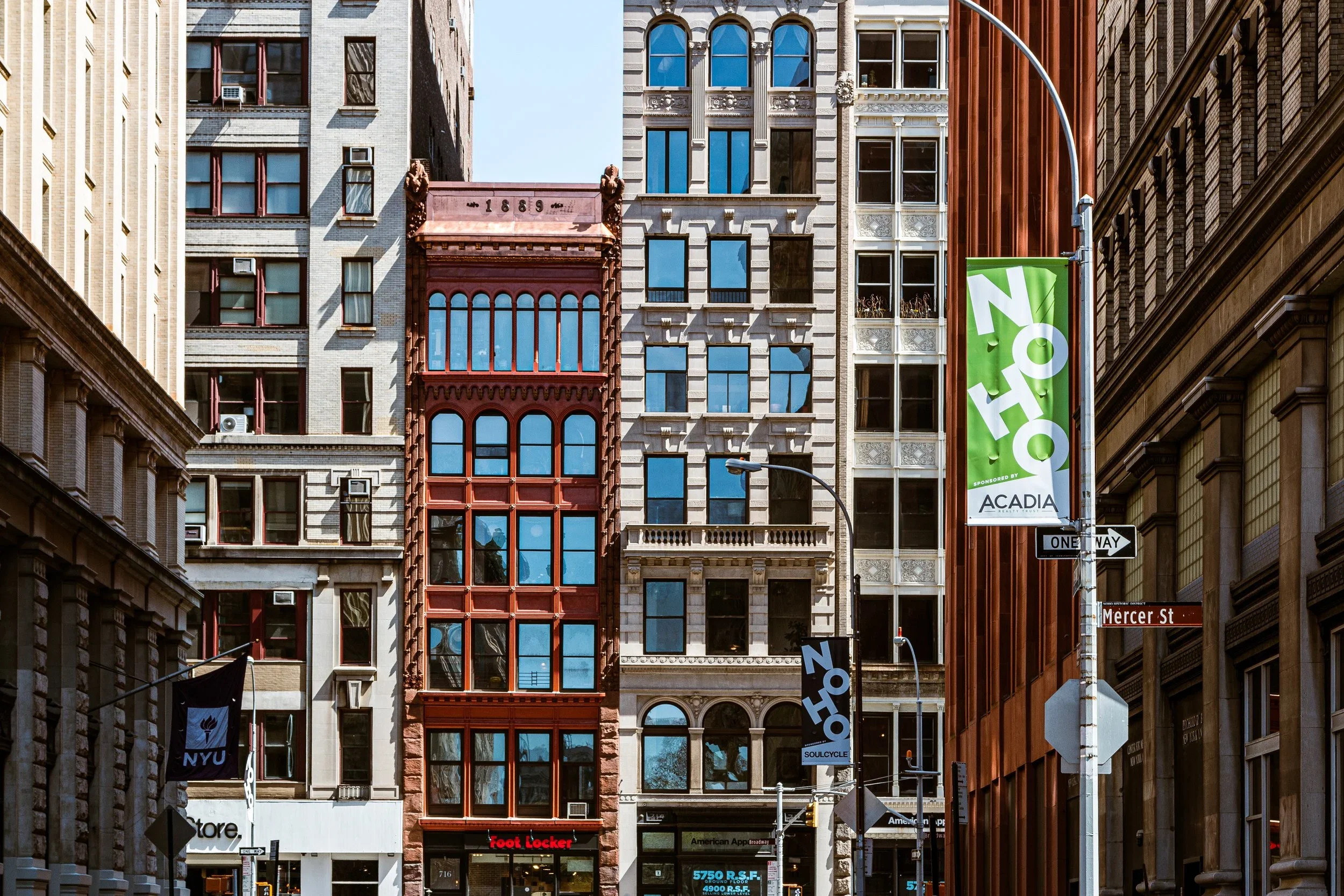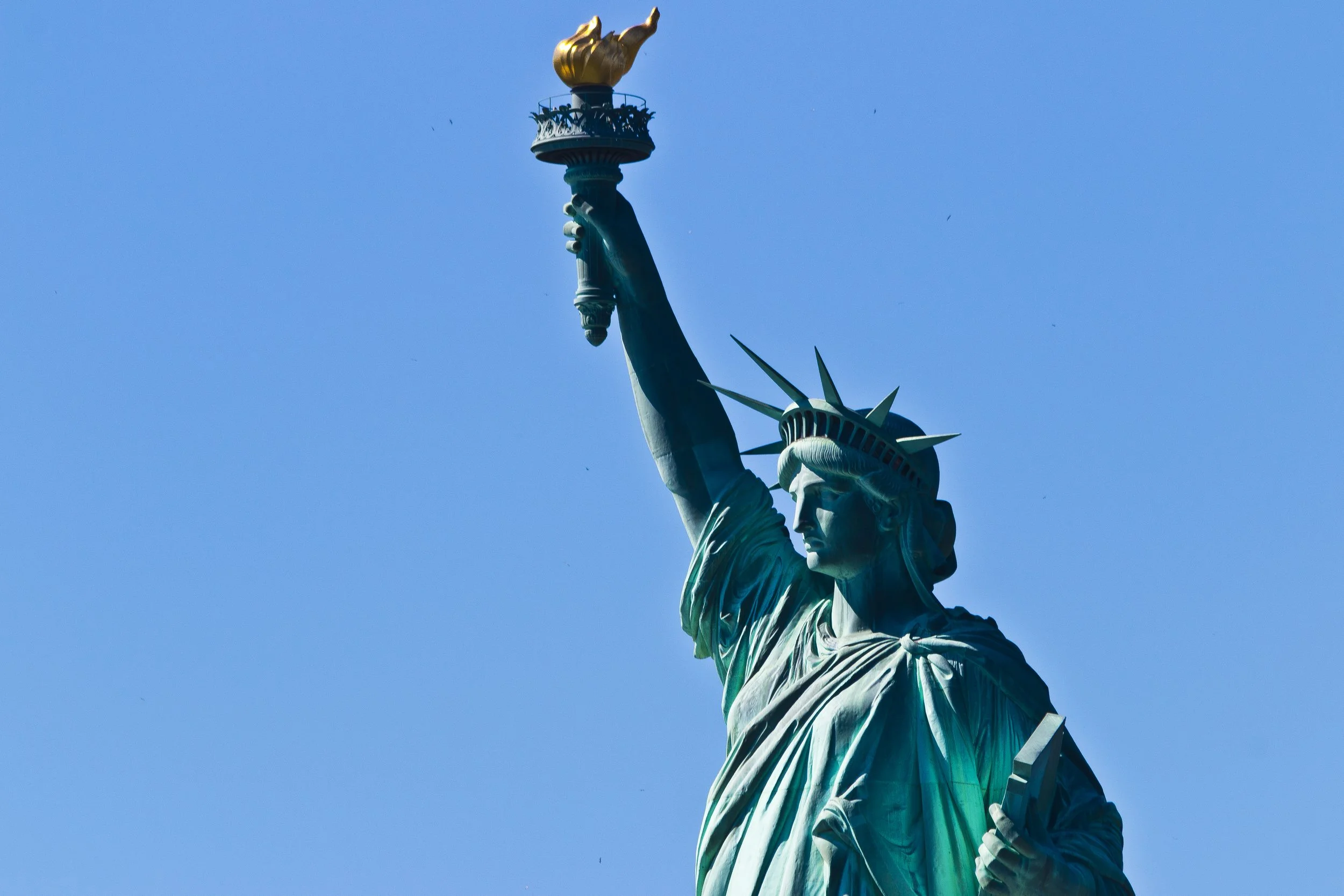
NOHO
Geographic Setting
Bounded by Houston Street to the south and East 8th Street to the north, and between Mercer Street on the west and the Bowery on the east, NoHo—short for “North of Houston”—occupies one of Manhattan’s most architecturally exquisite and historically resonant enclaves. Tucked between SoHo’s cast-iron grandeur and the East Village’s bohemian sprawl, this small district embodies New York’s layered evolution from mercantile city to modern cultural capital.
NoHo’s grid is compact but profoundly rich. Along Bond, Great Jones, and Bleecker Streets, 19th-century warehouses and lofts—crafted in cast iron, marble, and red brick—now house design studios, theaters, galleries, and apartments whose high ceilings and broad windows speak to their industrial origins. Lafayette Street bisects the neighborhood north–south, while Astor Place forms its northern hinge, linking NoHo to Greenwich Village’s academic and theatrical worlds. Eastward, the Bowery—the city’s oldest thoroughfare—anchors NoHo’s frontier character, its mix of mission churches, hotels, and avant-garde performance spaces still testifying to the area’s social range. Compact yet monumental, NoHo is one of the most complete 19th-century streetscapes left in Manhattan—its cobblestones and façades a living archive of the city’s artistry and reinvention.
Etymology and Origins
The name “NoHo” originated in the late 1970s, coined by real-estate developers and preservationists who sought to distinguish this emergent historic district from SoHo (“South of Houston”), its more famous neighbor below. Yet the land’s history reaches back to colonial times. In the 17th and 18th centuries, the area lay within the De Lancey family’s estate and later within the “Vauxhall Gardens”—a pleasure ground of music, fireworks, and promenades that occupied much of present-day Lafayette Street between Bleecker and 9th. By the early 19th century, as New York’s grid extended northward, the area developed as a genteel residential quarter of Federal-style townhouses, gradually giving way to commerce and light manufacturing by midcentury.
The later adoption of the “NoHo” name was more than branding—it was a declaration of identity. It affirmed the neighborhood’s kinship with SoHo in architectural heritage and artistic energy, while asserting its own distinct balance of preservation and progress.
The Neighborhood
19th Century: From Patrician Streets to Mercantile Lofts
In the early 1800s, Bond, Great Jones, and Lafayette Streets were among the city’s most fashionable addresses. Elegant Federal and Greek Revival homes lined the newly opened Lafayette Place (completed 1829)—a wide, tree-lined boulevard envisioned by merchant John Jacob Astor as a showcase of refinement. Astor built the Lafayette Terrace of marble-fronted townhouses and the grand Astor Library (1854), designed by Alexander Saeltzer, as cultural cornerstones for the rising bourgeoisie.
By midcentury, however, the city’s elite had moved uptown, and commerce took hold. The once-residential blocks sprouted cast-iron and masonry loft buildings designed by masters such as Griffith Thomas, Samuel Warner, and Henry Fernbach. These structures—distinguished by rhythmic façades, Corinthian columns, and vast interior spans—housed textile merchants, piano manufacturers, and importers. Bond Street in particular became synonymous with craft and culture: its fine architecture attracted photographers, artisans, and printers even after the brownstones gave way to warehouses.
The Bowery, long a major artery, remained more raucous—lined with theaters, beer halls, and boardinghouses—but its proximity to Lafayette’s formality created a dynamic tension unique to NoHo: elegance beside edge, art beside enterprise.
Early 20th Century: Industry, Theater, and Transition
By the early 1900s, NoHo had matured into a thriving light-industrial district. Piano makers like Steinway & Sons and textile firms occupied its lofty buildings, while printers and publishers filled the upper floors. Yet cultural life persisted amid the industry. The Astor Library, merged in 1895 with the Tilden and Lenox collections to form the New York Public Library, later became the Joseph Papp Public Theater (1967)—a turning point in NoHo’s artistic identity.
The Cooper Union for the Advancement of Science and Art (founded 1859 just beyond Astor Place) exerted an intellectual influence that continued into the 20th century. Its Great Hall hosted orators from Abraham Lincoln to Frederick Douglass, anchoring NoHo’s reputation as a center of civic and cultural discourse. The district’s mix of art, architecture, and industry fostered a bohemian vitality even before artists formally reclaimed the lofts.
Mid–Late 20th Century: Decay, Rediscovery, and Preservation
As industry declined after World War II, NoHo’s warehouses emptied. By the 1960s, its cast-iron buildings—like those of SoHo—faced demolition threats. Yet artists and preservationists saw potential in the lofty spaces and ornate façades. Painters, sculptors, and theater collectives moved into the disused lofts, forming an underground community of creativity and resilience.
In 1965, The Public Theater opened in the repurposed Astor Library under Joseph Papp’s visionary leadership, launching works by Shakespeare, Sam Shepard, and later Lin-Manuel Miranda’s Hamilton—securing NoHo’s place in American performing arts history. Meanwhile, architectural preservation gained traction. The NoHo Historic District (designated 1999, expanded 2008) formally recognized the area’s 19th-century building stock as one of the city’s most intact mercantile landscapes.
Civic groups and residents successfully resisted high-rise encroachment, ensuring that NoHo’s narrow streets and cast-iron character would survive even as surrounding neighborhoods transformed. What had once been marginal real estate became among the city’s most coveted—proof that preservation could coexist with creative renewal.
21st Century: Design, Culture, and Controlled Transformation
Today, NoHo exemplifies adaptive urbanism—where 19th-century artistry meets contemporary design. Its historic lofts now house fashion ateliers, architecture studios, tech firms, and high-end residences. New buildings by architects such as Annabelle Selldorf, Morris Adjmi, and Herzog & de Meuron reinterpret the cast-iron idiom with restraint and respect, using brick and steel in dialogue with their surroundings.
Cultural life thrives: The Public Theater remains an incubator of American performance; La MaMa Experimental Theatre Club, founded nearby in 1961, continues to influence global avant-garde theater; and Cooper Union endures as an educational and civic anchor. Boutiques, restaurants, and cafés occupy restored storefronts on Bond and Great Jones Streets, their signage modest to preserve the district’s architectural integrity.
Despite its exclusivity, NoHo retains a certain democratic spirit—its sidewalks alive with students, performers, and residents who sense the neighborhood’s layered legacy. The juxtaposition of 19th-century lofts and 21st-century design creates a dialogue between past and present, art and architecture, that few places in Manhattan can match.
Spirit and Legacy
NoHo’s legacy is one of reinvention through reverence. It is a neighborhood that has survived each cycle of New York’s evolution—aristocratic enclave, mercantile district, industrial ghost town, artistic refuge—and emerged more refined, more self-aware, and more vital each time. Its architecture remains a living museum of craftsmanship; its theaters and institutions, an engine of cultural progress.
New York City
Use this custom Google map to explore where every neighborhood in all five boroughs of New York City is located.
The Five Boroughs
One of New York City’s unique qualities is its organization in to 5 boroughs: Manhattan, Brooklyn, Queens, The Bronx, and Staten Island. These boroughs are part pragmatic administrative districts, and part vestiges of the region’s past. Each borough is an entire county in New York State - in fact, Brooklyn is, officially, Kings County, while Staten Island is, officially Richmond County. But that’s not the whole story …
Initially, New York City was located on the southern tip of Manhattan (now the Financial District) that was once the Dutch colony of New Amsterdam. Across the East River, another city was rising: Brooklyn. In time, the city planners realized that unification between the rapidly rising cities would create commercial and industrial opportunities - through streamlined administration of the region.
So powerful was the pull of unification between New York and Brooklyn that three more counties were pulled into the unification: The Bronx, Queens, and Staten Island. And on January 1, 1898, the City of New York unified two cities and three counties into one Greater City of New York - containing the five boroughs we know today.
But because each borough developed differently and distinctly until unification, their neighborhoods likewise uniquely developed. Today, there are nearly 390 neighborhoods, each with their own histories, cultures, cuisines, and personalities - and each with residents who are fiercely proud of their corner of The Big Apple.

